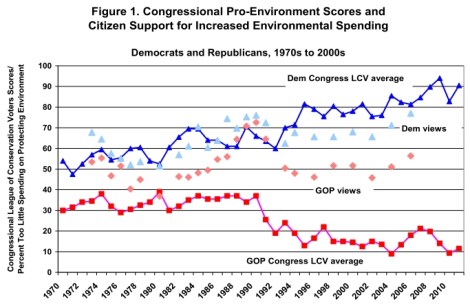The great cap-and-trade battles of 2009-10 were, for me, the culmination of an obsession that began in earnest around 2006, when Democrats re-took the House. You may recall the heady days of the 2007 Democratic primaries, when all three of the serious candidates for president — Barack Obama, Hillary Clinton, and John Edwards — had competing cap-and-trade plans, as did the eventual GOP nominee, John McCain. Back then it seemed extremely important to hash out the fine policy details. It was virtually all I thought about, for years on end.
In the end it all crashed and burned. There have been many partial (in both senses of the word) accounts of how that happened, and why, but it’s been the subject of remarkably little serious, scholarly attention. So I’m glad the Rockefeller Family Fund commissioned Harvard political scientist Theda Skocpol to do a deep dive into the story [PDF] and extract what lessons she could.
Philip has a good rundown on her paper, but of course I can’t resist adding my $0.02.
First off: Overall, it’s good. I know there’s no point in asking you to read a 140-page PDF, but if you’re interested in the episode, you won’t find a more clear-eyed account.
I couldn’t help smiling when, after sifting through various post-mortems on the cap-and-trade battle, Skocpol concluded that “each player tended to blame others and conclude that whatever approach he/she/it favored all along would be the best one to double-down on moving forward.”
So true. That’s a perpetual danger in these kinds of retrospectives (a danger to which Skocpol is as vulnerable as anyone). The cap-and-trade battle is like the fabled elephant and the blind men. Everyone came to it from a different perspective, saw different things, and learned different lessons. The way it looked to a Waxman staffer is very different from how it looked to an oil executive or an enviro leader. Looking back, it’s easy to project whatever you want to see onto it. Many people have.
It’s also important to remember that if things had been just a little different — if the filibuster were off the table, for example, or the recession hadn’t hit when it did — the bill would have passed and everyone would be writing about how savvy the USCAP strategy was and how brilliant enviro leaders are. Important historical turning points can hinge on contingencies. We have a strong propensity, after the fact, to shoehorn events into narratives that make the outcome seem inevitable, or at least predictable. We want things to make sense. But in the words of the philosophers: Shit happens.
All that said, while no one is immune to the pundit’s fallacy, Skocpol mostly gets the important things right. Here are a couple of lessons from the paper that are worth reinforcing:
Enviros vastly overstated Obama’s agency throughout the process and his responsibility for the outcome. Skocpol exaggerates enviro cluelessness a bit here — I doubt all that many really think they would have won if Obama had just made a few more speeches — but she’s definitely on to something. An amazing amount of the commentary around the bill was devoted to criticizing Obama, or saying what Obama should do, or questioning Obama’s heart. Enviros were constantly “calling on” Obama to say or do this thing or the other. But Obama was not at the center of the action. The dynamics that mattered took place in Congress. Obama did not exactly distinguish himself as a climate champion, but he was a sideshow — he could not have changed the outcome.
On public opinion, cap-and-trade supporters were too concerned with breadth and too little concerned with intensity. An enormous amount of time and money went into national polls and national advertising. National polls tell enviros what they want to hear: In the abstract, majorities always support clean air and clean energy. Enviros mistook these poll results for constituencies. But poll results do not attend town halls or write members of Congress or exhort their fellow citizens through ideological media. Constituencies do that.
And national advertising, pitched at a vague, gauzy level meant to appeal to everyone by saying very little (more jobs!), rallied no one in particular. It was advertising designed to juice national poll numbers, not to fire up any constituency in particular.
Meanwhile, on the right, the Tea Party faction was organized, loud, and incredibly passionate. An intense, activated constituency beats broad, shallow public support every time. Intense constituencies are levers that move politicians. Polls aren’t. (If you doubt me, consider the fact that sensible gun-control measures are backed by large majorities, while opposed by the NRA. Seen any sensible gun-control measures lately?)
Failure to fight back in the summer of 2009 was a fateful mistake. Just after the Waxman-Markey bill passed the House, summer arrived, legislators went home, and enviros cracked a beer and put their feet up. Meanwhile, a well-funded, well-organized Tea Party invaded town halls, dominated talk radio and Fox News, and generally scared the bejesus out of Republican legislators. They bashed on “cap-and-tax” for months, with very little pushback. By the time the Senate returned to consider the bill, members had learned their lesson.
The previous three can be summarized as a fourth:
Enviros were slow to perceive and understand the accelerating radicalization of the Republican Party. The USCAP strategy was based on securing the support — or at least defusing the opposition — of key business constituencies. The presumption was that the GOP is the party of business and would follow the lead of key corporate constituents.
It was further based on securing the support of key “maverick” Republicans like John McCain and Lindsey Graham. The presumption there was that their support would provide cover for other moderate Republicans to cross the line.
Both presumptions were based on an outdated model of the Republican Party. Now, Skocpol exaggerates a bit here, too. In 2006-7, when the USCAP negotiations were getting underway, there was still a widespread feeling, at least among center-left types, that an era of divisive, hard-right politics was ending and an era of moderation was in sight. Lots and lots of people failed to anticipate the Tea Party. (Not me! I’ve been saying the GOP is on the crazy train since they accused Bill Clinton of having Vince Foster murdered.)
Even today, much of the political and journalistic elite fails to grasp the reality of asymmetrical polarization. Fewer understood it in 2006. You can argue, as Skocpol does, that D.C. enviro groups were clueless, but if they were, they had lots of company.
Skocpol, in contrast to many who have written about cap-and-trade, gets it (perhaps because she wrote the book on the Tea Party). She understands that the root of the cap-and-trade fiasco lies not in the details of climate science or policy, but in larger political dynamics. Specifically: The radicalization of the conservative movement is the problem. It is no longer business interests that wield the most influence in the Republican Party, but a network of ideological billionaires and the think tanks, media outlets, and astroturf organizations they fund. They do not need broad public sentiment on their side. They just need Republicans in their thrall.
I wish I could inscribe this quote from Skocpol in the D.C. sky:
[T]he capacity of opponents to stymie carbon-capping legislation does not depend on general popularity or appeals to middle-of-the-road public opinion. It depends, instead, on leverage within the Republican Party, which in turn can use institutional levers in U.S. government to stymie or undermine governmental measures to fight global warming.
Conservative billionaires and activists, unlike enviros, understood that the key to power is using intense constituencies to leverage the institutional might of a political party. They didn’t primarily try to shift the public; they shifted the party. That explains why congressional Republicans have radicalized so much more, and more quickly, than average Republican voters. The far right has taken over. Here’s what that looks like when it comes to environmental issues:
As you can see, sentiment among Republican voters (“GOP views”) has largely tracked the pro-environmental stance of Democratic voters. But since 1990, congressional Republicans have gotten more and more hostile to environmental protections. There was a brief time in the mid-2000s when (some) moderate Republicans approached climate change differently, but they were either driven from the party or brought to heel by McConnell party discipline in the Obama era. Republicans in Congress have lurched into a position of almost total oppositionalism on environmental protection.
D.C.-centered enviros were, oddly, some of the last to pick on this. Many of them still harbor dreams of back-room, bipartisan, Gang-of-Six, Grand-Bargain dealmaking. Environmental Defense Fund President Fred Krupp hasn’t changed his tune at all. But that dream is forlorn, says Skocpol:
Ever since global warming became prominent on the environmental agenda, an all-out political fight has been underway, and reformers do themselves no favor by refusing to clearly understand the scope of the battle or the degree to which politicians, including almost all Republicans now in office, have been recruited into the opposition.
Furthermore, all trends point toward further radicalization. Gerrymandering has put huge numbers of House Republicans in districts they can effectively never lose, giving them absolute license. Demographic trends are working against Republicans overall, but in midterm elections their primary constituency — older white people — still dominates, which helps insure a continuing GOP House majority. There are right-wing billionaires with near-limitless appetite for political spending and virtually no rules left to constrain them.
In short, says Skocpol, “there is no reason to believe that today’s radicalized Republicans will be willing to stand down any time soon from their fierce opposition to virtually all environmental regulations and their refusal to countenance legislation to deal with climate change.”
So there you have it. Though the death of cap-and-trade was multi-causal and complicated, the principle explanation lies in the broader radicalization of the Republican Party. Climate hawks need to internalize this, to realize that, even if they personally don’t like to be on “a side,” don’t like to be “partisan,” don’t like to be “unreasonable,” their opponents have no such reservations. The far-right base sees itself as involved in a war for Western civilization and sees the Republican Party as its instrument. Any future effort to pass national climate change legislation will be about overcoming unified, implacable GOP opposition.
So what does this say about future climate politics? That’s where I think Skocpol goes off the rails a bit. More on that in my next post.
Read David Roberts’ second post on Theda Skocpol’s report, and then his third.
For still more on the report, here’s a summary by Philip Bump and responses from Bill McKibben, Eric Pooley, Joe Romm, Mark Hertsgaard, and Mike Tidwell, plus a followup post from Skocpol herself.





